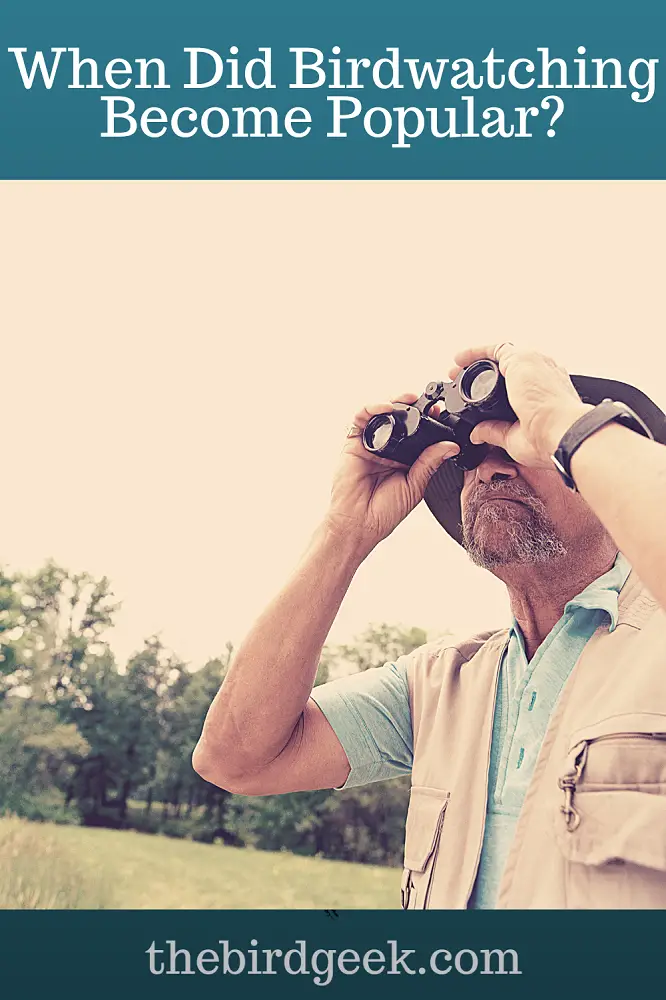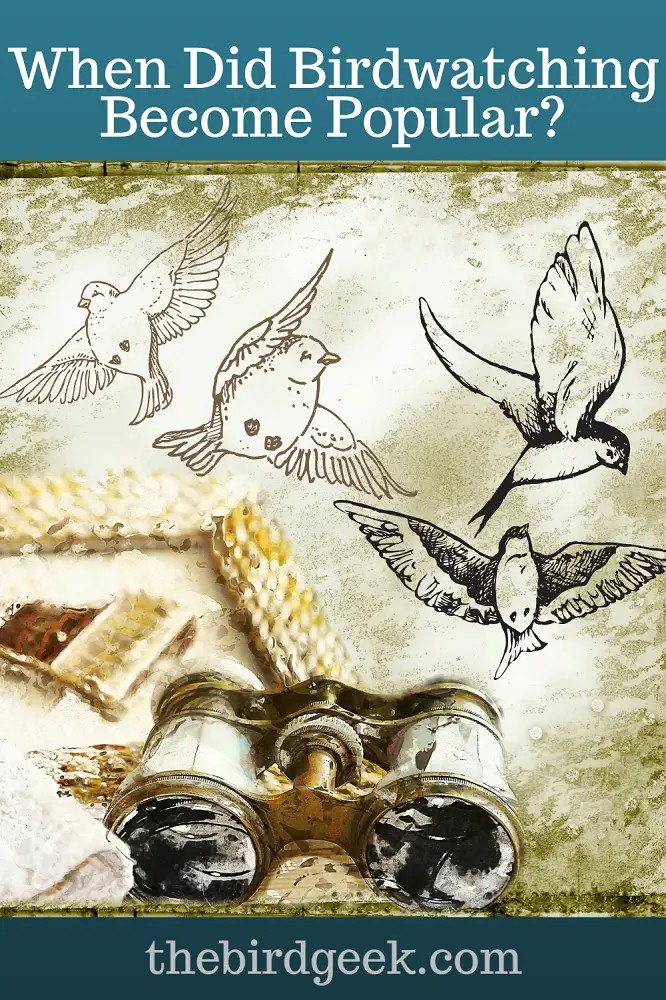When Did Birdwatching Become Popular?
Over the last century or so, birdwatching has steadily risen in popularity in many parts of the world and has expanded beyond its first-world origins. While it is still the most popular in the areas where it originated, it has spread far beyond these regions to become an engaging activity for many people, including those in rural areas. Its popularity is due to many different factors, such as relative inexpensiveness.
In this article, we’ll examine not only the current popularity of birdwatching but highlight its history and how it became the popular pastime it is today. You might be surprised to learn just how many people have turned into amateur birders over the years. There’s also some information about this hobby’s history that may also shock you, including its relatively new origin.

When Did Birdwatching Originate?
In the past, people watched birds with one intention: eating. That’s because birds have been a food source for people since ancient times, due to their widespread nature. Hunters in ancient times devised multiple techniques for watching and stalking birds, methods that helped them stay hidden and get close enough to birds to attack them with a bow, sling, or other weapons.
However, this type of birdwatching is not what most modern birders enjoy. Modern birding is an inherently passive and violence-free pastime. Birders simply watch their favorite species in their natural environment to learn more about how they live. Others simply enjoy taking pictures of these birds and sharing them with others, including on various social media networks.
At what point did stalking a bird for food and watching a bird for pleasure diverge? Modern birdwatching can be traced to the 18th century, when the quality of life in more developed countries had improved to the point where hunting birds was no longer important for survival. While some early birders also hunted, it was around this time that birding as a pastime originated.
That said, it still took over 100 years before birding became more popular in its modern form. Early birders were engaged in studying birds and often collected eggs, skins, and even birds for their collections. Modern birders may be horrified to learn of this collecting because gathering such items is typically illegal in most countries now. This difference showcases how far birding has come from its earliest roots.
The Early Interest in Birding
During the late 1700s, writers like Gilbert White, George Montagu, Thomas Bewick, and John Clare became popular for studying birds and discussing natural history. They operated around the world and collected various eggs, skins, and much more to learn more about how birds lived. Their early interest in birds led to increased interest in birds and their living environments.
That said, it is clear that these earlier birders were not particularly interested in preserving or protecting these species. They didn’t think anything of killing and preserving rare birds and studying them under the microscope or cracking eggs with viable embryos inside. In this way, these earlier birders were more scientists than hobbyists and focused on learning more about these creatures.
Obviously, this approach is vastly different from that of the gentle modern birder. Many birders prefer buying the biggest possible binoculars so that they see birds from far away without disrupting their nests. The ideas of protection and preservation have become very important in the birding community. Rather than dissecting them, modern birders simply prefer watching their favorite species.
This change came about in the 1800s and was the result of changes in attitudes among various birding communities. It is likely around then that the break from scientific study versus simple observation became pronounced. There are a few names that need to be discussed when analyzing this topic, including some that you might know and others that may be new to you.
How Modern Birdwatching Evolved
Throughout the mid-to-late 1800s, conservation started to attract the attention of many writers. For example, John James Audubon was one of the most popular and influential writers and artists of his time in the birding field. Audubon was respected for his hundreds of bird drawings and paintings, as well as his study of multiple bird species. This led to an increasing interest in protecting birds.
For example, The Audubon Society formed in America to protect birds, particularly against the feather trade that was popular at the time. The Royal Society for the Protection of Birds played a similar role in Britain and started to advocate against shooting birds for identification. Amazingly, most scientists and birders thought that shooting and killing birds was the only way to properly identify them.
However, the invention of optics, like binoculars, helped to make it easier to see birds clearly from a distance without having to disrupt or shoot them. Just as importantly, field identification guides were published throughout the late 1800s that caught the attention of the public. For instance, the first known birding book, “Birds Through an Opera Glass” was published by Florence Bailey in 1889.
Its success led to an increase in birding popularity throughout the eastern seaboard region of the United States. In these settled areas, it wasn’t as necessary to hunt birds for food, allowing people to simply identify them rather than eat them. Other birding books were published during this time, including “Bird Neighbors,” a guide that sold over 250,000 copies: a major success at the time.
Increasing Mobility Leads to Higher Birding Popularity

For many years, birding’s popularity was regional, meaning that birders could only see species within their area. It was too hard and time-consuming for people to travel more than a few hundred miles away from their home. However, the invention of the gas-powered engine made it easier for people to travel far and wide, as did train travel and even later, airplane flight.
After the end of World War II, as the world experienced a major economic boom that ushered in the modern age, birding in far-away areas became more popular. Books like “Where to Watch Birds” by John Gooders focused heavily on multiple regions and allowed birdwatchers to identify more species than ever. The concept of birding for pleasure or vacationing just to birdwatch became a thing.
For instance, a company called Ornitholidays started in 1965 and was the first birding touring company. Other businesses like these formed in its wake. Birding book publication became a very competitive field, with multiple field guides emerging every year. These books expanded to include species far beyond specific regions and even moved to international and global scopes.
For instance, the publication of the book, “The Handbook of the Birds of the World,” started in the 1990s and covered multiple countries throughout the world. The idea was to create a comprehensive book that contained as many species as possible. It and other guides like it have become the standard field birdwatching bible for birders and have been published in many languages.
The Further Spread of Birding’s Popularity
For many years, birding was primarily a hobby in well-developed areas, particularly in the United States and United Kingdom. The hobby originated in these countries and remains very prevalent here. However, less-developed areas have started to pick up on the hobby, particularly as their culture improves financially. It has also become a popular way for parents to enjoy time with their children.
For example, the African Bird Club formed in 1994 to promote birdwatching and provide a community for people in Africa interested in birds. They also focus heavily on conserving and studying African birds to help protect them from environmental damage. This group is just one example of how far birding has spread and the unique impact that it has had on many parts of the world.
When Did Birdwatching Become Popular in the US?
History shows that birding has a strong connection to the United States, arguably beginning here with the word of John James Audubon, among many others. As for when it became popular, that’s a bit harder to gauge. Audubon’s popular drawings were well-received in England and throughout the United States throughout the 1840s and 1850s and triggered an increased interest in America. Though other experts were writing about birds at the time, Audubon’s work simply captured the imagination more fully.
As a result, it was with his publication that increased interest in birding began, and the hobby has had a steady increase in popularity since then. While there have been changes in its popularity throughout history, it is clear that it has been popular for nearly 200 years. In fact, some believe that birding is even more popular now than it has ever been, with more people having high levels of leisure time.
Furthermore, the low cost of birding (a pair of binoculars and some field clothes) has made it a great hobby for people of limited means. In a world where inflation is rising and the cost of living is becoming harder for many people to handle, going out into the woods with a pair of binoculars and watching gentle birds in their natural environment is appealing to more and more people every day.
Related post: Best Children’s Birdwatching Books
What is the Hobby of Birdwatching Called?
Many people simply call birdwatching by that simple name because it tells you exactly what is happening. You’re watching birds in their natural habitat and can track how they live from a safe distance. Birdwatchers try to avoid interrupting or affecting a bird’s life, staying far away and watching them with binoculars whenever possible. This makes them some of the most conscientious hobbyists in the world.
However, birdwatching does have a different name that is commonly used by many in the field: birding. Some prefer this nomenclature because it is more neutral than birdwatching as a term. Birdwatching implies a certain sense of voyeurism that some birders find uncomfortable. As a result, more modern fans have stuck with the “birding” term as an alternative to birdwatching.
Related post: Birdwatching Rules and Etiquette
Is Birdwatching Becoming More Popular?
There are a few different ways to gauge the popularity of birdwatching around the world. First, we could examine search trends in Google and other search engines. According to Google’s records, birdwatching peaked in search popularity between April and May of 2004 and has been on a steady decline in recent years, though the term remains relatively stable.
Typically, popularity varies depending on the season, with warmer months getting more interest than winter seasons. Beyond this variance, it is also important to note that birding has overtaken birdwatching as the most commonly searched term related to this hobby. As mentioned previously, this likely indicates the growing preference for the word “birding” over “birdwatching” in many circles.
Related post: Best Birdwatching Podcasts
Why Did Birdwatching Peak in April 2004?
The sudden increase in popularity in “birdwatching” as a search term was likely due to the heavy population increase of the Great Gray Owl and Northern Hawk Owl in North America during that year. Known as the Great Irruption, this major event was reported by many news outlets at the time and probably led to more people searching birdwatching and birding during those early months.
Birding Popularity by Clubs
It is important to note that internet searches don’t dictate all there is to know about birding popularity. For example, a survey by the U.S. Fish and Wildlife Services found that about 45.1 million Americans watch birds in the country: that’s about 20% of the entire population of the country. The United Kingdom also has a high number of birders, with one million official members of the Royal Society for the Protection of Birds and about six million actively engaged birders in the country.
Where is Birdwatching the Most Popular?
Based on the sheer number of birders, it is likely that birding is the most popular in the United States. With a full 20% of its population engaging in some form of birding, it’s hard to compete. Ironically, the United Kingdom has the highest Google search for birding in the world by far, followed by Italy, Ireland, Portugal, and Poland. These areas also have millions of birders.
Related post: Get To Know Famous Birdwatchers All Over The World
Conclusions – When did birdwatching become popular?

To wrap things up, we can see that birdwatching originated as a hobby in the late 1700s, when birders and scientists watched and captured birds, feathers, eggs, and nests for their personal collections and education. During the 1800s, movements began to protect wild birds, and binoculars were invented, allowing people to observe birds from afar. With gorgeously illustrated birding guides becoming available, birdwatching became popular on the east coast of the US in the late 1800s.
After World War II, advances in travel and improvements in the economy meant the average person could travel far and wide to enjoy their hobby. Today, it is estimated that nearly 20% of people in the US enjoy birdwatching!






